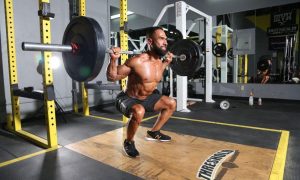“Auxiliary exercises are not just for show—they’re for building the strength you can’t see.”—Louie Simmons
The SFL StrongFirst Barbell Instructor Certification is a rigorous test of strength, technique, and resilience, demanding mastery of fundamental barbell lifts: the back squat, bench press, military press, and deadlift. To earn the SFL Certification, candidates must demonstrate impeccable form under heavy loads while meeting strict performance standards.

While the core lifts are the heart of the certification, auxiliary exercises can play an indispensable role in preparing for the physical and technical demands of the SFL. This article explores why auxiliary exercises can be essential for building strength, refining technique, preventing injury, and ensuring success in training for the StrongFirst Lifter Certification
Having worked as a Team Leader and assistant at several SFLs, I often see people failing to meet certification standards due to a lack of specific muscle strength. For instance, the military press technique test—especially for women—is often a place where people struggle and need to spend several more weeks or months training to submit a successful video for approval. I have also seen people fail the deadlift strength test, usually when a breakdown in technique occurs due to a lag in specific muscle strength.
Many people who sign up for the SFL come to it as a second, third, or fourth option on their way to becoming a StrongFirst certified elite instructor and, in that journey, have spent a considerable amount of time training in a minimalist program using bodyweight or kettlebells. They aren’t as familiar with the proper training methods needed to improve barbell lifts. As a strength athlete with extensive barbell experience, I’ve found that training for the SFL often requires a different approach than the SFG, SFG II, or SFB.
Students would benefit from using auxiliary exercises to address the specific muscle weaknesses that may be holding back their lifts.
Auxiliary exercises, also known as accessory or supplemental movements, are lifts that complement the primary barbell exercises. Unlike the main lifts, which build raw strength and power, auxiliary exercises target specific weaknesses, improve movement quality, and enhance overall performance. For SFL candidates, auxiliary exercises serve four key purposes: building strength in supporting muscles, refining technique, preventing injury through the strengthening of supportive tissues, and addressing individual limitations. They may just be the key to a proper training cycle leading up to the SFL.

Before we begin, it may be prudent to digress for a moment to talk about prioritizing training. A common mistake students make is trying to do too much at once. Rather than simultaneously training to achieve the Simple standard and improve your pistol squat, dedicate a full training block to specifically prepare for the SFL. In other words, take a few months and train as if you were preparing for a powerlifting competition. This means breaking your training into set days for specific lifts, focusing on the barbell squat, bench press, military press, and deadlift, and incorporating auxiliary exercises to address weaknesses.
Here’s how you do it.
Building Strength in Supporting Muscles
The squat, bench press, military press, and deadlift are compound lifts that engage multiple muscle groups simultaneously. However, certain muscles may lag behind, creating weak links that limit performance or compromise form. Auxiliary exercises target these supporting muscles to ensure balanced strength development.
- Back squat: The back squat requires a strong posterior chain (glutes, hamstrings, and lower back), trunk stability, and quad strength. Exercises like Romanian deadlifts, glute-ham raises, reverse hyper extensions, Ukrainian deadlifts, kettlebell swings, and barbell hip thrusts strengthen the posterior chain. Belt squats, goblet squats, and step-ups can build brutal quadricep strength.
- Bench press: A powerful bench press depends on the chest, shoulders, triceps, and upper back. Dips, close-grip bench presses, skull crushers, JM presses, Tate presses, pushdowns and one arm dumbbell extensions target tricep and shoulder strength, while bent over rows, one-arm rows, seated cable rows, pullups, face pulls, and rear delt raises bolster the upper back for better stability.

- Deadlift: The deadlift demands grip strength, posterior chain power, and trunk rigidity. Romanian deadlifts, Ukrainian deadlifts, reverse hypers, hyper extensions, and good mornings build posterior chain strength, while ab wheel roll-outs, standing cable crunches, and side bends build trunk strength and stability.
- Military press: The military press is one of the most demanding movements in the SFL and requires upper back, shoulder, and triceps strength, as well as a strong trunk. Exercises like lateral raises, bent lateral raises, face pulls, and cable rows will build the upper back, while pushdowns and skull crushers will build strong triceps.

Auxiliary exercises enable lifters to handle heavier loads with confidence and control by strengthening these supporting muscles—a necessity for meeting SFL standards. These exercises build the muscle needed to move the loads, while building the tendon and ligament strength to stabilize the weight being moved. If your muscles can handle 95 pounds but your ligaments can only handle 80 pounds—you’re pressing 80 pounds.
The SFL places a premium on technical perfection. Even minor deviations in technique, such as a collapsing chest in the squat or flaring elbows in the bench press—can lead to failed lifts or disqualification. Auxiliary exercises help ingrain proper movement patterns and address technical flaws. A stronger muscle is a more efficient muscle.
Preventing Injury Through Balanced Development
Training for the SFL involves weeks of intense lifting, which can strain joints, tendons, and muscles if not managed carefully. Auxiliary exercises promote balanced development, reducing the risk of overuse injuries and ensuring longevity in training.
- Trunk stability: The SFL lifts require a rock-solid trunk to transfer force and protect the spine. Exercises like ab wheel roll-outs, hanging leg raises, standing cable or band crunches, and side bends strengthen the trunk, preventing lower back injuries during heavy squats and deadlifts.
- Joint health: High-rep, low-weight movements like band pull-aparts or scapular pushups improve shoulder and scapular health, counteracting the stress of heavy bench pressing.
There are simple ways to add joint health movements to your training, without spending extra time in the gym. For example, elbow tendons and ligaments can be worked by simply taking a light band, looping it over a door, and performing one hundred triceps pushdowns.

High repetition exercises with minimum weight can drive blood to the tendons and ligaments and improve strength and longevity for those vital structures. You can do the same thing with the structures of the knee. Sit on a chair and anchor a light band to a stationary object. Then perform one hundred seated leg curls and one hundred leg extensions. Finish off with three rounds of the hard style plank, holding it for 15-30 seconds. Do this 3-4 times per week and you will be happy with the results.
By addressing potential weak points and promoting recovery, auxiliary exercises help candidates stay healthy and ready for the demands of SFL testing.
Addressing Individual Weaknesses
Each lifter has unique strengths and weaknesses. One candidate might struggle with lockout strength in the deadlift, while another might lack the upper back strength needed for a stable bench press. Auxiliary exercises can provide customized programming to target these individual limitations.
To maximize the benefits of auxiliary exercises, SFL candidates can integrate them strategically into their training program using these practical tips:
- Prioritize volume and variety: Perform 2–4 auxiliary exercises per session, focusing on 3–5 sets of 8–12 reps to build muscle and endurance. Rotate exercises weekly or every three weeks to prevent plateaus.
- Complement the main lifts: Choose auxiliary exercises that directly support the squat, bench, or deadlift. For example, pair squats with Romanian deadlifts or bench presses with triceps extensions.
- Incorporate recovery days: Include lighter auxiliary sessions or mobility-focused days to promote recovery and maintain movement quality.
- Track progress: Monitor improvements in auxiliary lifts to gauge overall strength gains and adjust programming as needed.
In future articles, we’ll spend more time on programming and the rotation of special exercises. For now, here’s what a sample weekly schedule might look like:
- Day 1 (squat focus): back squat (main lift), Romanian deadlifts, reverse hypers, ab wheel roll-outs.
- Day 2 (bench focus): bench press (main lift), dumbbell skull crushers, pushdowns, dumbbell rows, face pulls.
- Day 3 (deadlift focus): deadlift (main lift), Ukrainian deadlift, hyperextensions with weight, leg curls, standing cable ab crunches.
- Day 4 (military press focus): military press (main lift), bent over rows, dumbbell rear lateral raises, one-arm dumbbell extensions.
Conclusion
The SFL is a test of strength, skill, and discipline. Auxiliary exercises are a cornerstone of effective preparation. By building supporting joint and tendon strength, refining technique, preventing injury, and addressing individual weaknesses, these exercises can equip candidates to meet the SFL’s demanding standards. Whether you’re a seasoned lifter or new to barbell training, incorporating auxiliary exercises into your program will enhance your performance and set you on the path to SFL success. Stay committed, train with intention, and let your auxiliary work lay the foundation for earning your SFL StrongFirst Barbell Instructor Certification.

At StrongFirst we are experts at making
the weak strong and the strong stronger.




